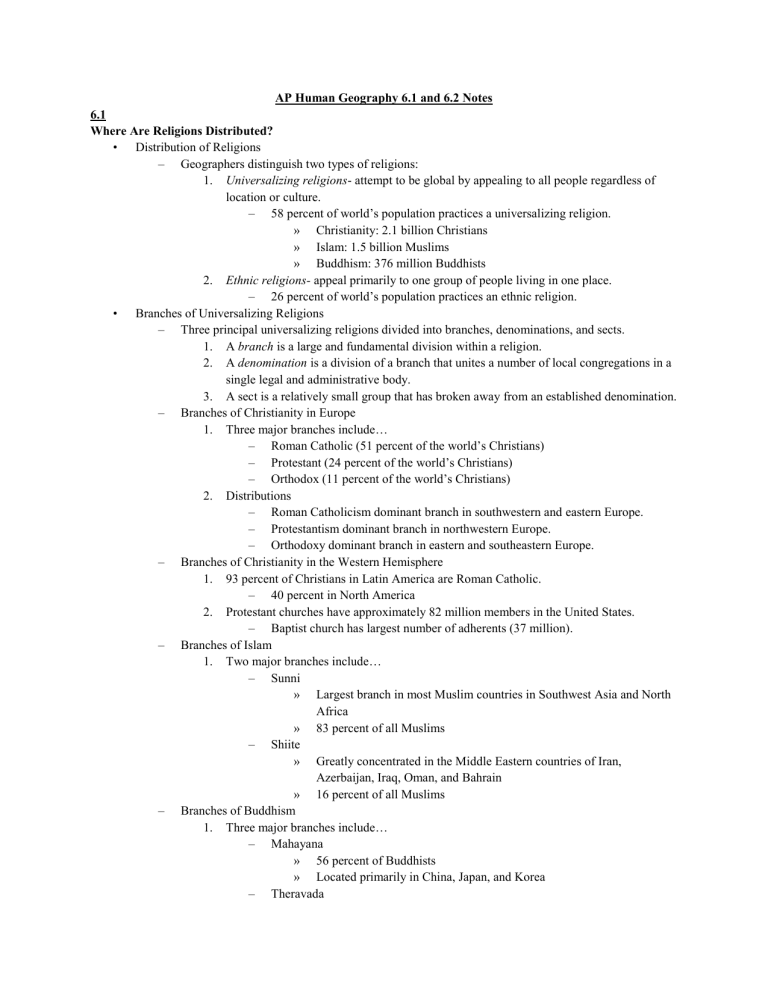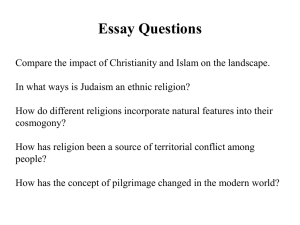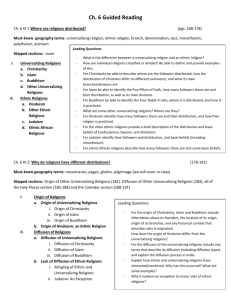AP Human Geography 6.1 and 6.2 Notes 6.1 Where Are Religions

AP Human Geography 6.1 and 6.2 Notes
6.1
Where Are Religions Distributed?
• Distribution of Religions
– Geographers distinguish two types of religions:
1.
Universalizing religions - attempt to be global by appealing to all people regardless of location or culture.
– 58 percent of world’s population practices a universalizing religion.
» Christianity: 2.1 billion Christians
» Islam: 1.5 billion Muslims
» Buddhism: 376 million Buddhists
2.
Ethnic religions appeal primarily to one group of people living in one place.
– 26 percent of world’s population practices an ethnic religion.
• Branches of Universalizing Religions
– Three principal universalizing religions divided into branches, denominations, and sects.
1.
A branch is a large and fundamental division within a religion.
2.
A denomination is a division of a branch that unites a number of local congregations in a single legal and administrative body.
3.
A sect is a relatively small group that has broken away from an established denomination.
– Branches of Christianity in Europe
1.
Three major branches include…
– Roman Catholic (51 percent of the world’s Christians)
– Protestant (24 percent of the world’s Christians)
– Orthodox (11 percent of the world’s Christians)
2.
Distributions
– Roman Catholicism dominant branch in southwestern and eastern Europe.
– Protestantism dominant branch in northwestern Europe.
– Orthodoxy dominant branch in eastern and southeastern Europe.
– Branches of Christianity in the Western Hemisphere
1.
93 percent of Christians in Latin America are Roman Catholic.
– 40 percent in North America
2.
Protestant churches have approximately 82 million members in the United States.
– Baptist church has largest number of adherents (37 million).
– Branches of Islam
1.
Two major branches include…
– Sunni
» Largest branch in most Muslim countries in Southwest Asia and North
Africa
» 83 percent of all Muslims
– Shiite
» Greatly concentrated in the Middle Eastern countries of Iran,
Azerbaijan, Iraq, Oman, and Bahrain
» 16 percent of all Muslims
– Branches of Buddhism
1.
Three major branches include…
– Mahayana
» 56 percent of Buddhists
» Located primarily in China, Japan, and Korea
– Theravada
» 38 percent of Buddhists
» Located primarily in Cambodia, Laos, Myanmar, Sri Lanka, and
Thailand
– Vajrayana
» 6 percent of Buddhists
» Located primarily in Tibet and Mongolia.
• Ethnic Religions
– Often remain within the culture where they originated.
– Typically have relatively more clustered distributions than do universalizing religions.
– Ethnic religion with largest number of followers is Hinduism.
1.
900 million adherents
– Nearly all concentrated in India and Nepal
– A combination of Buddhism (a universalizing religion) with Confucianism, Taoism, and other traditional Chinese practices is practiced in East Asia and Southeast Asia.
1.
Blending or combining of several traditions is known as syncretism .
– Animism is an ethnic religion whose followers believe that inanimate objects or natural events, such as natural disasters, have spirits and conscious life.
1.
100 million Africans adhere to animism.
– Judaism
1.
First recorded religion to espouse monotheism, belief that there is only one God.
– Contrasts polytheism - the worship of a collection of gods.
2.
Distribution
– 2/5 live in the United States
– 2/5 live in Israel.
3.
Christianity and Islam find some of their roots in Judaism.
6.
2
Why Do Religions Have Different Distributions?
• Origins of Religions
– Universalizing regions have precise places of origin.
1.
Often based on events in the life of an influential man.
– Ethnic religions not tied to single historical individual; often have unclear or unknown origins.
– Buddhism
1.
Founded: ~2,500 years ago
2.
Founder: Siddhartha Gautama
3.
Origin: India
– Christianity
1.
Founded: ~2,000 years ago
2.
Founding: Based on teachings of Jesus
3.
Origin: Region located in present-day Palestine
– Islam
1.
Founded: ~1,500 years ago
2.
Founder: Prophet Muhammad
3.
Origin: Makkah (Mecca) located in present-day Saudi Arabia
4.
Why Do Religions Have Different Distributions?
• Diffusion of Religions
– Asia is home to each hearth for Christianity, Islam, and Buddhism.
– Followers transmitted the messages preached in the hearths to people elsewhere.
– Each of the three main universalizing religions has a distinct diffusion pattern.
1.
Why Do Religions Have Different Distributions?
– Christianity
1.
Hierarchical Diffusion
– Emperor Constantine helped diffuse the religion throughout the Roman Empire by embracing Christianity.
2.
Relocation Diffusion
– Missionaries , individuals who help transmit a religion through relocation diffusion, initially diffused the religion along protected sea routes and the excellent Roman roads.
– Migration and missionary activity by Europeans since 1500 have extended
Christianity all over the world.
» Permanent resettlement in the Americas, Australia, and New Zealand
3.
Why Do Religions Have Different Distributions?
– Islam
1.
Muhammad’s successors organized followers into armies and led a conquest to spread the religion over an extensive area of…
– Africa
– Asia
– Europe
2.
Relocation diffusion of missionaries to portions of sub-Saharan Africa and Southeast
Asia transmitted the religion well beyond its hearth.
3.
Why Do Religions Have Different Distributions?
– Buddhism
1.
Diffused relatively slowly from its origin in northeastern India.
2.
Emperor Asoka accredited with much of its diffusion throughout the Magadhan Empire
(273 to 232 B.C.).
– Missionaries sent to territories neighboring the empire.
3.
Buddhism introduced to China along trade routes in the first century A.D.
4.
Why Do Religions Have Different Distributions?
– Ethnic Religions
1.
Most have limited, if any, diffusion.
– Lack missionaries
2.
Diffusion to new places is possible, if adherents migrate for economic gains and are not forced to adopt a strongly entrenched universalizing religion.
3.
Judaism’s diffusion is unlike other ethnic religions because it is practiced well beyond its place of origin.
– Other nationalities have historically persecuted Jews living in their midst because of their retention of Judaism.









